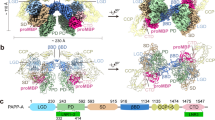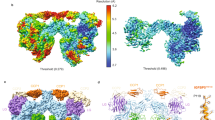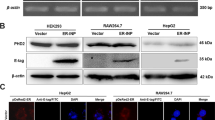Abstract
The pregnancy-related serine protease HtrA3 plays an important role in human placental development and has recently been recognized as a potential therapeutic target in the treatment of cancer. Previously, a C-terminal pentapeptide FGRWV–COOH was identified to bind at the PDZ domain of HtrA3 with a moderate affinity. Here, based on the high-resolution complex crystal structure of HtrA3 PDZ domain with the pentapeptide ligand we successfully introduced a rationally designed halogen bond to the complex interface by substituting R4-hydrogen atom of the indole moiety of peptide Trp-1 residue with a halogen atom. High-level theoretical calculations suggested that bromine is the best choice that can render strong interaction energy for the halogen bond and can confer high affinity to the PDZ–peptide complex. Fluorescence spectroscopy characterizations revealed that the resulting R4-brominated peptide (K d = 0.15 ± 0.03 μM) exhibited 12-fold affinity improvement relative to its nonhalogenated counterpart (K d = 1.8 ± 0.4 μM). In contrast, the PDZ-binding affinity of R6-brominated peptide (K d = 1.2 ± 0.1 μM), a negative control that was unable to form the halogen bond according to theoretical investigations, did not change substantially as compared to the nonhalogenated peptide.




Similar content being viewed by others
References
Adamo C, Barone V (1998) Exchange functionals with improved longrange behavior and adiabatic connection methods without adjustable parameters: the mPW and mPW1PW models. J Chem Phys 108:664–675
Bayly CI, Cieplak P, Cornell WD, Kollman PA (1993) A well-behaved electrostatic potential based method using charge restraints for deriving atomic charges: the RESP model. J Phys Chem 97:10269–10280
Berman HM, Westbrook J, Feng Z, Gilliland G, Bhat TN, Weissig H, Shindyalov IN, Bourne PE (2000) The protein data bank. Nucl Acids Res 28:235–242
Boys SF, Bernardi F (1970) The calculation of small molecular interactions by the differences of separate total energies. Some procedures with reduced errors. Mol Phys 19:553–566
Chung LW, Sameera WM, Ramozzi R, Page AJ, Hatanaka M, Petrova GP, Harris TV, Li X, Ke Z, Liu F, Li HB, Ding L, Morokuma K (2015) The ONIOM method and its applications. Chem Rev 115:5678–5796
Duan Y, Wu C, Chowdhury S, Lee MC, Xiong G, Zhang W, Yang R, Cieplak P, Luo R, Lee T, Caldwell J, Wang J, Kollman P (2003) A point-charge force field for molecular mechanics simulations of proteins based on condensed-phase quantum mechanical calculations. J Comput Chem 24:1999–2012
Fogolari F, Brigo A, Molinari H (2002) The Poisson-Boltzmann equation for biomolecular electrostatics: a tool for structural biology. J Mol Recognit 15:377–392
Glaza P, Osipiuk J, Wenta T, Zurawa-Janicka D, Jarzab M, Lesner A, Banecki B, Skorko-Glonek J, Joachimiak A, Lipinska B (2015) Structural and functional analysis of human HtrA3 protease and its subdomains. PLoS One 10:e0131142
Guo X, He D, Huang L, Liu L, Liu L, Yang H (2012) Strain energy in enzyme-substrate binding: an energetic insight into the flexibility versus rigidity of enzyme active site. Comput Theor Chem 995:17–23
Liu W, Wen W, Wei Z, Yu J, Ye F, Liu CH, Hardie RC, Zhang M (2011) The INAD scaffold is a dynamic, redox-regulated modulator of signaling in the Drosophila eye. Cell 145:1088–1101
Lu Y, Shi T, Wang Y, Yang H, Yan X, Luo X, Jiang H, Zhu W (2009a) Halogen bonding: a novel interaction for rational drug design? J Med Chem 52:2854–2862
Lu Y, Zou J, Fan J, Zhao W, Jiang Y, Yu Q (2009b) Ab initio calculations on halogen-bonded complexes and comparison with density functional methods. J Comput Chem 30:725–732
Nie G, Li Y, Minoura H, Batten L, Ooi GT, Findlay JK, Salamonsen LA (2003) A novel serine protease of the mammalian HtrA family is up-regulated in mouse uterus coinciding with placentation. Mol Hum Reprod 9:279–290
Nie G, Li Y, Hale K, Okada H, Manuelpillai U, Wallace EM, Salamonsen LA (2006) Serine peptidase HTRA3 is closely associated with human placental development and is elevated in pregnancy serum. Biol Reprod 74:366–374
Rocchia W, Alexov E, Honig B (2001) Extending the applicability of the nonlinear Poisson-Boltzmann equation: multiple dielectric constants and multivalent ions. J Phys Chem 105:6507–6514
Runyon ST, Zhang Y, Appleton BA, Sazinsky SL, Wu P, Pan B, Wiesmann C, Skelton NJ, Sidhu SS (2007) Structural and functional analysis of the PDZ domains of human HtrA1 and HtrA3. Protein Sci 16:2454–2471
Senn HM, Thiel W (2009) QM/MM methods for biomolecular systems. Angew Chem Int Ed Engl 48:1198–1229
Singh H, Makino S, Endo Y, Li Y, Stephens AN, Nie G (2012) Application of the wheat-germ cell-free translation system to produce high temperature requirement A3 (HtrA3) proteases. Biotechniques 52:23–28
Sitkoff D, Sharp KM, Honig B (1994) Accurate calculation of hydration free energies using macroscopic solvent models. J Phys Chem 98:1978–1988
Voth AR, Khuu P, Oishi K, Ho PS (2009) Halogen bonds as orthogonal molecular interactions to hydrogen bonds. Nat Chem 1:74–79
Wang J, Wolf RM, Caldwell JW, Kollman PA, Case DA (2004) Developing and testing of a general amber force field. J Comput Chem 25:1157–1174
Acknowledgments
This work was supported by the Weifang Medical University.
Author information
Authors and Affiliations
Corresponding author
Ethics declarations
Conflict of Interest
None.
Statement of Informed Consent
Not applicable.
Statement of Human and Animal Rights
Not applicable.
Rights and permissions
About this article
Cite this article
Liu, H., Dou, SF., Zhang, X. et al. Rational Improvement of Peptide Affinity to Human Pregnancy-Related Serine Protease HtrA3 PDZ Domain by Introducing a Halogen Bond to the Domain–Peptide Complex Interface. Int J Pept Res Ther 22, 371–376 (2016). https://doi.org/10.1007/s10989-016-9516-x
Accepted:
Published:
Issue Date:
DOI: https://doi.org/10.1007/s10989-016-9516-x




